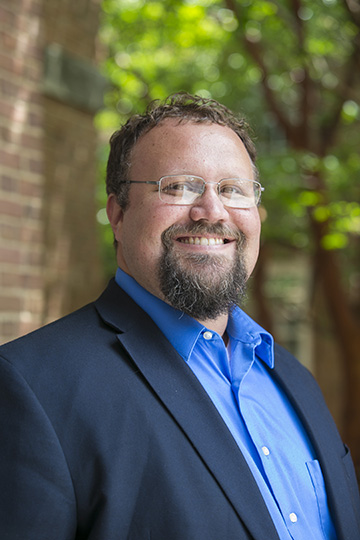
Position: Assistant Professor of Journalism and Mass Communication
Teaching at Samford since: 2014
Why do you teach? I teach because it helps me feel like I’m making a difference to society. I have always viewed journalism as a public service job, something one does to make his or her community—or, in some cases, country or world—a better place. Now, I have the opportunity to cultivate that perspective in young, energetic people who can go on to do great things. I’m really motivated by the opportunities I have to see students use the communication tools they’ve developed in a way that serves others.
What is one thing your students may not know about you? When I was a kid, my dream was to be a stand-up comedian. At that time, the cable network Comedy Central primarily aired clips of stand-up performances, so I spent hours watching comics like Jon Stewart and Jerry Seinfeld (and many who never became famous). I owned tons of cassettes of big-name comics and regional performers like Jerry Clower and Lewis Grizzard. I believe those hours of listening to and watching stand-up influence the way I carry myself in the classroom in some ways. I still think about writing a set someday and performing it at an open-mic night somewhere.
How do you help students understand the constantly changing world of journalism? By reminding them that, while the way we “do” journalism has changed dramatically in the last 15 years, the central purpose of well-done journalism remains the same: to inform people in order to facilitate a better public conversation. If one starts from that central idea, it can be easier to navigate the rapid technical, economic and cultural changes in media that we see every day.
How did your background prepare you for your current role at Samford? I feel very fortunate to have worked at several different kinds of newspapers, doing a lot of different kinds of jobs. As a result, I think I bring a great deal of perspective on not just the mechanics of writing and editing, but also the broader social and ethical issues that students who go on to work in media (or in other types of workplaces, for that matter) may encounter. Being a good journalist also requires a certain level of empathy that translates well into working with students.
What is some of the interesting research you are currently doing? Currently, I am focused on the completion of a book manuscript about news coverage of poverty. The book, which is due out in fall 2017, is about small newspapers in three rural Appalachian towns with high levels of poverty, and how they go about choosing when and how to write about that poverty. None of the news outlets I studied covered economic need with regularity. One of the main points of the book is that their silence about the issue reinforces a lot of the barriers that prohibit significant social improvements in small towns.
What is one thing you want your students to know when they graduate from Samford? I want students to know that they have a social responsibility to be informed about their communities and the world around them. Digital and social media have put an extraordinary amount of information at our fingertips. But they have also made it easier for us to be misinformed, or to live in information silos inhabited only by those who share a narrow set of beliefs. It takes effort to really understand the problems and opportunities we and others face. I want students to know that the end results are worth that effort.
Tell us about Local, the student-produced magazine for which you serve as instructor/adviser. The Local is an award-winning magazine about Birmingham developed by JMC’s print/digital media practicum program. One of the great things about Local is that I am only minimally involved in it; students develop story ideas, write stories, shoot photos, sell and design ads, and lay out pages. They make difficult decisions about content and work out staff disputes, often with little or no interference from me. The classes that produce Local are rewarding in many different ways. Probably my favorite aspect of the class is that, every year, it is a venue for students to step up and become real leaders in a fairly intense professional atmosphere.